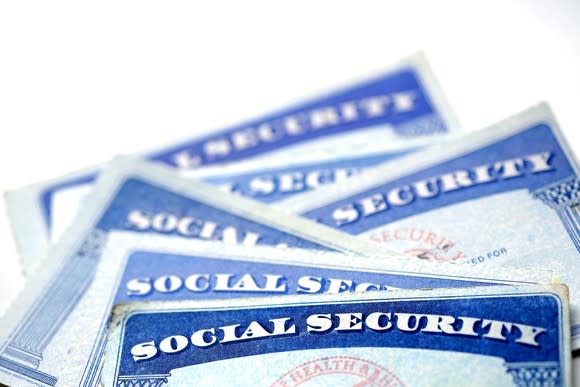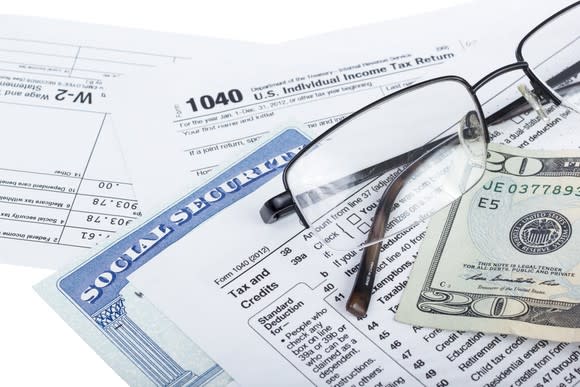Ending the Taxation of Social Security Benefits Would Cost $552 Billion Over 10 Years
Social Security is undoubtedly one of the most important social programs in our country. As of December, almost 62 million beneficiaries were receiving a monthly stipend from the program, with 42.4 million of those folks being retired workers. A majority of these retirees (62% to be exact) rely on their Social Security payout to account for at least half of their monthly income.
Social Security is in trouble
Yet the program that tens of millions of seniors have come to rely on could soon fail them. According to the 2017 report from the Social Security Board of Trustees, the Old-Age, Survivors, and Disability Insurance (OASDI) Trust is expected to begin paying out more in benefits than it's generating in revenue by 2022. Just 12 years later, in 2034, the approximately $3 trillion in asset reserves is projected to be completely gone.

Image source: Getty Images.
Now, there is a silver lining to all of this for seniors: Social Security won't be going bankrupt. More than 87% of the $957.5 billion collected by the program in 2016 was derived from the payroll tax on earned income. This year, that payroll tax applies to earned income between $0.01 and $128,400. As long as Congress doesn't change how the program is funded, and Americans continue to work and earn income, Social Security will always have revenue that it can disburse to eligible beneficiaries.
Unfortunately, survival isn't the same thing as sustainability. The projections from the Board of Trustees are crystal clear that the current payout schedule simply isn't sustainable. Changes are needed from Congress to shore up Social Security and provide much needed security for seniors during their golden years.
What changes should be made? If seniors had their say, the first change to be made would be the elimination of the taxation of benefits.
The archaic Social Security tax that's pilfering middle-income seniors
Back in 1983, with the Social Security program facing an actuarial deficit that was about a third of the size it is now, the Reagan administration implemented a sweeping overhaul of the program that was designed to cut long-term costs and generate more revenue. Among the ways new revenue was to be generated was the implementation of a tax on Social Security benefits for individuals and couples earning over a certain threshold each year. This threshold was set at $25,000 in adjusted gross income (AGI) for single tax filers and $32,000 for couples filing jointly, and it allowed 50% of Social Security benefits to be subjected to federal income tax.

Image source: Getty Images.
A decade later in 1993, the Clinton administration added another tier that would allow the federal government to tax up to 85% of Social Security benefits. Individual taxpayers earning over $34,000 in AGI, and couples filing jointly making in excess of $44,000 in AGI are subject to this higher rate.
When signed into law in 1983, the taxation of benefits was only expected to affect around 10% of all senior households. However, The Senior Citizens League notes that this tax now affects 56% of all senior households. The reason we've seen such a huge jump in the likelihood of seniors having their Social Security benefits taxed is that the aforementioned AGI thresholds haven't been adjusted for inflation since inception. The result is that this tax is now affecting upper- and middle-income seniors.
Seniors want this tax eliminated, but it comes with a hefty price tag
Not surprisingly, a survey undertaken in March 2017 by The Seniors Center, a Washington, D.C.-based nonprofit organization, found that an overwhelming number of seniors want the taxation of benefits repealed -- 91% of senior respondents, to be exact. Overall, 88% of senior respondents noted that their living expenses have risen, while 68% pointed to a rise in their healthcare costs. These rising costs are becoming tougher to cover when seniors have to hand back some of their retired worker benefits to Uncle Sam.

Image source: Getty Images.
While eliminating the taxation of benefits is something that both Democrats and a few Republican lawmakers have considered, it comes with a pretty big long-term cost. The Board of Trustees' income projections for the program between 2017 and 2026 pegs an aggregate intake of $552.4 billion from the taxation of benefits, based on the intermediate-cost model. Now mind you, Social Security is already staring down an estimated $12.5 trillion cash shortfall between 2034 and 2091. Eliminating the taxation of benefits would increase that amount even more. It would likely also move forward the projected depletion date of asset reserves.
Thus we have one of the biggest Social Security dilemmas. Do we:
Keep the tax in place because we want to pack the OASDI Trust with as much in asset reserves as possible; or
Eliminate this tax, or at minimum update the income thresholds for inflation over the past couple of decades, and boost middle-income seniors' take-home pay now, while at the same time worsening the long-term outlook for Social Security?
There is no simple answer here. And making matters worse, Democrats and Republicans agree on virtually nothing when it comes to Social Security, other than the fact that it's going to need to be fixed at some point in the next 16 years. Until we get some form of consensus in Washington, seniors and pre-retirees had better prepare themselves for the growing likelihood that they'll owe federal income tax on their Social Security benefits.
More From The Motley Fool
The Motley Fool has a disclosure policy.
